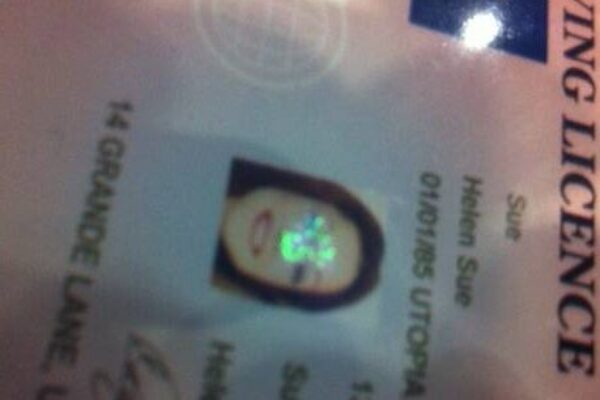
Smartcards more secure with invisibly printed optical encryption keys
At the company booth, International Key Account Manager for the NISS Group, Thomas Diamantidis demonstrated the virtually undetectable encoding technology for eeNews Europe. Taking two seemingly identical smart cards, he shone an IR laser across a small area of the cards, just a few millimetre square, to unveil a photo-luminescent dot pattern only on the genuine card.
Until then invisible, the bright dot pattern was printed out of a proprietary ink formulation featuring 25nm sized nanoparticles, whose IR-induced visible luminescence (in the green region) reveals the dot pattern to the appropriate card reader.

The patented technology (including encoding algorithms during dot printing and the management of non-repeatable codes in a printer’s database) is implemented as several product offerings that turn these stealth optical patterns into unique identification keys (up to 1024 combinations for the hexagonally-shaped Nano-ID code Diamantidis showcased.)
Equipped with an optical detection unit pointing at the hidden area of interest and running vision processing algorithms, the smart card reader can then decode the dot pattern and use the matching encryption key to decipher data encrypted on the secure chip (this reading step may be additionally secured with a PIN entry or fingerprint authentication from the reader’s operator).
These measures mean that even a cloned card (without the hard to detect dot pattern), would remain unreadable.
"We usually place the pattern centrally, but it could be printed just anywhere as it doesn’t affect the look and feel of the card", commented Diamantidis, "and the coding pattern could take any other shape or size depending on the specific requirements of our customers", he added, as the reader could also be customized for any given implementation.
The invisible code could be used not only as an encryption key on smart cards, but also more simply as an anti-counterfeit marker, ensuring the strong authentication of documents or even objects, for the sake of traceability or genuine certification. Indeed, Diamantidis showed me a number of tagged samples, including paper, plastic, leather, metal or even glass (only on a very polished hard surface, and looking closely at the right place, you could guess the printed dots’ texture).

As well as commercializing the readers, the NISS Group will either issue blank smart cards already tagged with a code (managing both the printing and the codes), or deliver dedicated printers and special ink cartridges with the appropriate embedded coding algorithms for their customers to do the printing and manage the encryption keys. But the company won’t give away its ink formulation nor its nanoparticle production process.
"These are trade secrets that add to the security level of our codes" explained Diamantidis.
But couldn’t the company just buy commercially available photo-luminescent inks or nanoparticles to implement their proprietary optical encoding and decoding scheme?
"Well, from the beginning, we wanted to control the actual spectral response of each batch of nanoparticles we produce, with the idea to formally identify the authenticity of the codes through their unique spectral response", explained Diamantidis.
"Exploiting this added security feature means integrating a spectrometer into our readers, and we do just that for a few customers". But because today’s spectrometers are still quite bulky and expensive, this added layer of security (assuming you had someone able to forge access tokens with meaningful luminescent codes), only makes sense in highly secure access applications. Diamantidis didn’t want to give names but hinted that some defence or spy agencies could be interested in incorporating such readers into heavily armoured walls.
A few years ahead on the company’s roadmap, a consumer mobile application could also leverage this invisible coding scheme, together with an optical mobile add-on (with an integrated IR laser) for consumers to authenticate luxury goods.
Because spectrum analysers are far from being mainstream in smartphones, the decoding wouldn’t take the nanoparticles’ unique spectral response into account, but eventually, this upgrade option will be there, hence the need for the company to always be in control of its own nanoparticles production process.
"We wouldn’t want to depend on anyone to source our nanoparticles. What’s more, by producing them ourselves, we can better control their physical properties to achieve the right viscosity in our ink formulations", concluded Diamantidis.
Visit the NISS Group at www.nissgroup.com
Related articles:
Software has the last word for PIN entry
 If you enjoyed this article, you will like the following ones: don't miss them by subscribing to :
eeNews on Google News
If you enjoyed this article, you will like the following ones: don't miss them by subscribing to :
eeNews on Google News




